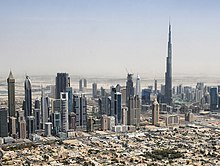
Back اقتصاد الإمارات العربية المتحدة Arabic Economía de los Emiratos Árabes Xuníos AST Birləşmiş Ərəb Əmirlikləri iqtisadiyyatı Azerbaijani Economia dels Emirats Àrabs Units Catalan Ekonomika Spojených arabských emirátů Czech Wirtschaft der Vereinigten Arabischen Emirate German Economía de los Emiratos Árabes Unidos Spanish Araabia Ühendemiraatide majandus Estonian اقتصاد امارات متحده عربی Persian Économie des Émirats arabes unis French
 Dubai, the financial center of the United Arab Emirates | |
| Currency | Emirati dirham (AED, د.إ) |
|---|---|
| US$1 = 3.6725 AED | |
| Calendar year | |
Trade organisations | OPEC, WTO, GCC, BRICS |
Country group |
|
| Statistics | |
| Population | |
| GDP | |
| GDP rank | |
GDP growth | |
GDP per capita | |
GDP per capita rank | |
GDP by sector |
|
Population below poverty line | N/A |
| 26.0 low (2018)[7] | |
| |
Labour force | |
Labour force by occupation |
|
| Unemployment | |
Main industries | |
| External | |
| Exports | |
Export goods | Crude oil, refined petroleum, gold, reexports, telecommunications equipment, diamonds, petroleum gas, jewellery, aluminium (2021)[12] |
Main export partners | |
| Imports | |
Import goods | Gold, food, machinery, transport vehicles and parts, refined petroleum, natural gas, diamonds, jewellery, refined copper (2021)[12] |
Main import partners |
|
FDI stock | |
Gross external debt | |
| Public finances | |
| −0.2% (of GDP) (2017 est.)[6] | |
| Revenues | 15.79 billion (2021 est.)[6] |
| Expenses | 16.6 billion (2021 est.)[6][note 1] |
| Standard & Poor's: AA[14] Outlook: Stable Moody's: Aa2 Outlook: Stable Fitch: AA Outlook: Stable | |
All values, unless otherwise stated, are in US dollars. | |
The United Arab Emirates is a high-income developing market economy. The UAE's economy is the 4th largest in the Middle East (after Turkey, Saudi Arabia and Israel), with a gross domestic product (GDP) of US$415 billion (AED 1.83 trillion) in 2021-2023.[5]
The UAE economy is heavily reliant on revenues from petroleum and natural gas, especially in Abu Dhabi. In 2009, more than 85% of the UAE's economy was based on the oil exports.[15][16] In 2011, oil exports accounted for 77% of the UAE's state budget.[17] In recent years, there has been some economic diversification,[18] particularly in Dubai.[clarification needed] Abu Dhabi and other UAE emirates have remained relatively conservative in their approach to diversification. Dubai has far smaller oil reserves than its counterparts.[19]
Tourism is one of the biggest non-oil sources of revenue in the UAE. A massive construction boom, an expanding manufacturing base, and a thriving services sector are helping the country to diversify its economy. Nationwide, there is currently US$350 billion worth of active construction projects.[20]
The UAE is a member of the World Trade Organization and OPEC.
- ^ "World Economic Outlook Database Groups and Aggregates Information". International Monetary Fund.
- ^ "World Bank Country and Lending Groups". datahelpdesk.worldbank.org. World Bank. Archived from the original on 28 October 2019. Retrieved 29 September 2019.
- ^ "united-arab-emirates". The World Factbook (2024 ed.). Central Intelligence Agency.
- ^ "Population, total". data.worldbank.org. World Bank. Archived from the original on 24 August 2019. Retrieved 24 August 2019.
- ^ a b c d e f g h i "Report for Selected Countries and Subjects: April 2024". imf.org. International Monetary Fund.
- ^ a b c d e f g h i j k l m n "The World Factbook". CIA.gov. Central Intelligence Agency. Archived from the original on 7 January 2022. Retrieved 13 June 2019.
- ^ "GINI index (World Bank estimate) – United Arab Emirates". data.worldbank.org. World Bank. Archived from the original on 30 March 2020. Retrieved 30 March 2020.
- ^ a b "Human Development Report 2023/2024" (PDF). United Nations Development Programme. 13 March 2024. Archived (PDF) from the original on 13 March 2024. Retrieved 15 June 2024.
- ^ "Labor force, total - United Arab Emirates". data.worldbank.org.
- ^ "Employment to population ratio, 15+, total (%) (national estimate)". data.worldbank.org. World Bank. Archived from the original on 24 August 2019. Retrieved 24 August 2019.
- ^ "Unemployment, total (% of total labor force) (national estimate)". data.worldbank.org. World Bank. Archived from the original on 7 January 2022. Retrieved 24 August 2019.
- ^ a b c "Export Partners of United Arab Emirates". The Observatory of Economic Complexity. Retrieved 7 April 2023.
- ^ "Import Partners of United Arab Emirates". The Observatory of Economic Complexity. Retrieved 7 April 2023.
- ^ "Sovereigns rating list". Standard & Poor's. Archived from the original on 26 June 2015. Retrieved 26 May 2011.
- ^ "The World Factbook". CIA. 12 January 2022. Archived from the original on 7 January 2022. Retrieved 20 February 2023.
- ^ "WTO Trade Statistic 2009". Stat.wto.org. Archived from the original on 4 March 2016. Retrieved 1 December 2014.
- ^ "Economic diversification in the GCC countries" (PDF). January 2013. p. 13. Archived from the original (PDF) on 5 December 2014. Retrieved 1 December 2014.
- ^ Kader, Binsal Abdul (20 April 2011). "Diversification raises non-oil share of UAE's GDP to 71%". Archived from the original on 1 March 2014. Retrieved 20 February 2023.
- ^ "United Arab Emirates profile". BBC News. 14 November 2012. Archived from the original on 27 November 2020. Retrieved 20 February 2023.
- ^ 3 Archived 2009-06-04 at the Wayback Machine
Cite error: There are <ref group=note> tags on this page, but the references will not show without a {{reflist|group=note}} template (see the help page).
© MMXXIII Rich X Search. We shall prevail. All rights reserved. Rich X Search